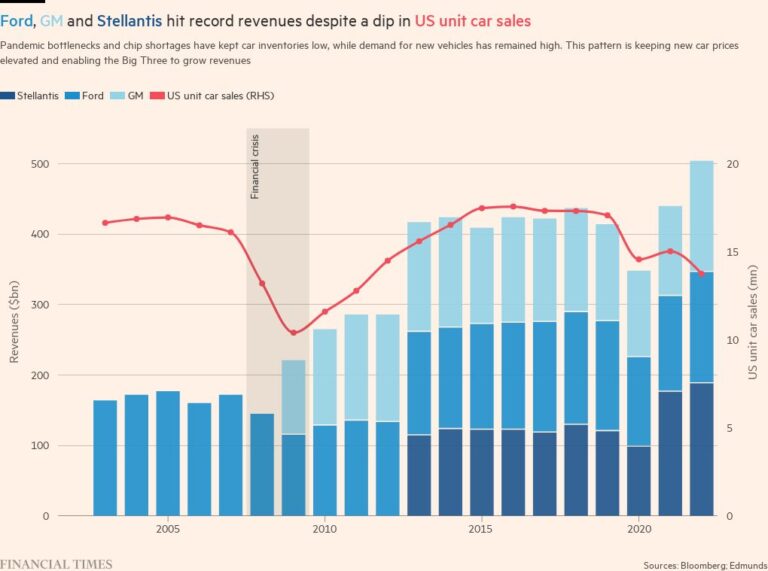
[ad_1]
Receive free Automobiles updates
We’ll send you a myFT Daily Digest email rounding up the latest Automobiles news every morning.
Shareholders and top bosses at General Motors, Ford and Stellantis have fared far better than workers in the past five years, as the US auto industry enjoyed a stunning recovery following the 2008 financial crash, according to Financial Times analysis.
As the strike called by the United Auto Workers union enters its second week, the sector is enjoying a boom that strengthens the union’s hand in negotiations. Filings show shareholders have received almost $85bn from the Detroit Three through dividends and buybacks since the crisis.
The UAW on Friday expanded strikes, hitting GM and Stellantis harder, while stepping back from raising pressure on Ford’s operations after it increased its pay offer.
All three carmakers remain locked in heated pay talks with the union, arguing they need resources to invest in electric vehicles and to compete in an increasingly tough global market.
However, the UAW points to stagnating wages and concerns that the shift towards EVs, which require fewer workers to assemble and take batteries from non-unionised plants, risks the future of organised labour among US car manufacturers.
Philippe Houchois, a global auto analyst at Jefferies, says bumper profits for carmakers have left manufacturers “cornered” during talks.
Steep rises in executive pay, especially at a time when most workers are suffering from the effects of soaring inflation, make demands for higher wages “such an easy narrative for the UAW to sell”, he adds.
In real terms, the wages of the average worker at all three carmakers have fallen by about 20 per cent in the five years to 2022 — largely driven by a pay decline at Ford.
Yet carmakers warn the union’s original demand for a 40 per cent increase — now whittled down to 36 per cent — risks the manufacturers’ financial health.
Ford CEO Jim Farley said the company would have “gone bankrupt by now” if it had paid the wages the UAW was demanding.
Carmakers have not publicly stated how much the UAW’s demand would cost them. Farley estimated Ford’s combined $30bn of profit over the past four years would have been a $15bn loss instead, indicating a $45bn gulf, while sources close to GM suggest a much higher cost hit of $80bn-$100bn.
PAYOUTS
Of the $84.9bn returned to investors since the crash, $52.7bn has been through dividends and $32.6bn from share buybacks.
These included a one-off dividend of $3.5bn from Fiat Chrysler ahead of the merger with PSA to form Stellantis in 2020 to equalise the value of the combining companies.
A large part of the total is driven by GM’s $26.3bn share buyback programme, which the company ran largely from 2012 to 2017 as it blossomed in the years following bankruptcy.
The payments have also perplexed observers, coming at a time when carmakers need to plough billions into electric cars to compete with Tesla.
“People will say: ‘You told us EVs are going to cost, but wasted so much money on buybacks,’” notes Houchois.
PROFITS
Combined profits at the three hit $70.3bn over 2021 and 2022, a number that would have been even higher had Ford not reported a $2bn loss last year following the writedown of start-up Rivian and self-driving venture Argo AI.
The profits were driven by rising prices as chronic global shortages of parts collided with robust post-pandemic demand.
For GM, 2021 was the most profitable year since it emerged from bankruptcy in 2009, with $10bn of income. Stellantis — which includes France’s PSA following the 2019 merger — made a record $17.7bn in net income last year, almost all coming from North America.
Even as the number of cars they sold dipped, aggregate revenues for the three carmakers hit $4tn over the past 10 years.
PAYOUTS
A sore point for the UAW has been the climbing earnings enjoyed by top executives, many of whom have their compensation linked to profits or other performance indicators such as shareholder returns.
There are some mitigating factors. Stellantis doubled in size after the merger with PSA and changed its CEO, with Peugeot’s Carlos Tavares leading the new business and replacing Fiat Chrysler’s Mike Manley.
Similarly, Ford replaced Jim Hackett in 2020 with Jim Farley, leading to a spike in 2020’s pay figures.
At GM, CEO Mary Barra’s pay grew 11 per cent in real terms in the five years to 2022 versus a decline of 10 per cent for the regular worker.
The 29 per cent pay increase at Stellantis compares with a 9 per cent fall for its average employee’s pay, after accounting for inflation.
Bumper executive pay is not restricted to the car industry, and is highly linked to wider economic factors.
“In 2021, when the economy was booming after the start of the pandemic in 2020, 82.5 per cent of CEOs received above-target bonus payouts,” says compensation and data group Equilar.
[ad_2]
Source link



